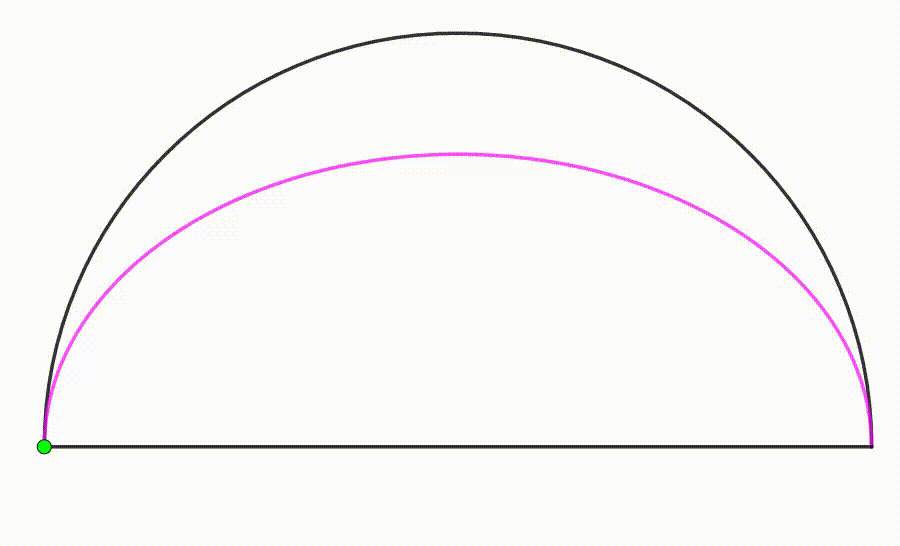Dynamic Geometry: P45
 The diagram shows a black semicircle. A cyan semicircle is moving freely inside the black semicircle so it is always internally tangent to it. The center of the cyan semicircle (green point) traces a
locus
(pink curve). When the area of the cyan semicircle is
maximum
, the ratio of its area to the area bounded by the pink curve and the black semicircle's diameter can be expressed as:
p
q
, where
q
and
p
are positive integers and
p
is square-free. Find
q
+
p
.
The diagram shows a black semicircle. A cyan semicircle is moving freely inside the black semicircle so it is always internally tangent to it. The center of the cyan semicircle (green point) traces a
locus
(pink curve). When the area of the cyan semicircle is
maximum
, the ratio of its area to the area bounded by the pink curve and the black semicircle's diameter can be expressed as:
p
q
, where
q
and
p
are positive integers and
p
is square-free. Find
q
+
p
.
The answer is 3.
This section requires Javascript.
You are seeing this because something didn't load right. We suggest you, (a) try
refreshing the page, (b) enabling javascript if it is disabled on your browser and,
finally, (c)
loading the
non-javascript version of this page
. We're sorry about the hassle.
2 solutions
Thank you for posting !

Let the center of big semicircle be O ( 0 , 0 ) , the origin of the x y -plane and its radius be 1 . Then the equation of the big semicircle is x 2 + y 2 = 1 . Let radius of the cyan semicircle be r and its center P (green point). Since the y -coordinate of P is always r , let its coordinates be P ( s , r ) . Then the equation of the cyan semicircle is ( x − s ) 2 + ( y − r ) 2 = r 2 or
x 2 − 2 s x + s 2 + y 2 − 2 r y + r 2 = r 2 ⟹ x 2 − 2 s x + s 2 + y 2 − 2 r y = 0
For the intersection points of the two semicircles, we have x 2 + y 2 = 1 , and the equation reduces to:
1 + s 2 − 2 s x − 2 r y = 0
This is the equation of the diameter of the cyan semicircle. And a point on the diameter is P ( s , r ) , putting x = s and y = r , we have:
1 + s 2 − 2 s 2 − 2 r 2 s 2 + 2 r 2 x 2 + 2 1 y 2 = 0 = 1 = 1 Replace s with x and r with y
Therefore the locus is half of an ellipse centered at ( 0 , 0 ) , with major-axis a = 1 , minor-axis b = 2 1 , and an area of 2 1 π a b = 2 2 π . The cyan semicircle has a maximum area when x = 0 and y = r = b = 2 1 and the area is 2 1 π ( 2 1 ) 2 = 4 π . The ratio of areas is:
4 π ⋅ π 2 2 = 2 2 = 2 1
Therefore p + q = 1 + 2 = 3 .
Let the black semi-circle have a radius of 1 and the blue semi-circle have a radius of r , extend the black semi-circle to a full circle, and draw the perpendicular bisector of the diameter of the blue semi-circle and label the diagram as follows:
Let k = O E . By the intersecting chord theorem , A E ⋅ E B = C E ⋅ E D , so r ⋅ r = ( 1 + k ) ⋅ ( 1 − k ) , which solves to k 2 = 1 − r 2 .
By the Pythagorean Theorem on △ O F E , O F 2 = O E 2 − E F 2 = k 2 − r 2 = ( 1 − r 2 ) − r 2 = 1 − 2 r 2 .
The pink curve can be defined by x 2 = O F 2 = 1 − 2 r 2 and y = r , which combines to x 2 + 2 y 2 = 1 , an ellipse with a semi-major axis of a = 1 and a semi-minor axis of b = 2 2 .
The area of the cyan semi-circle is a maximum when its center is directly above the center of the black semi-circle when r = b = 2 2 , and has an area of A b = 2 1 π r 2 = 2 1 π ( 2 2 ) 2 = 4 1 π .
The area between the pink curve and the black semicircle's diameter is half the area of the ellipse, so A p = 2 1 π a b = 2 1 ⋅ 1 ⋅ 2 2 = 4 2 π .
The ratio is then A p A b = 4 2 π 4 1 π = 2 1 , so q = 1 , p = 2 , and q + p = 3 .